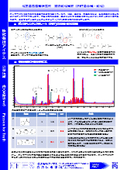Chemical Analysis Trusted Service
We would like to introduce our "Chemical Analysis - Trust Us Service."
When conducting component analysis of foreign substances or stains on products, it can be challenging to determine whether organic analysis or inorganic analysis is more suitable, and which specific analysis within organic or inorganic is the most appropriate. We provide a comprehensive service for customers who are struggling with the selection of analysis methods.
Since each analytical instrument is capable of measuring different targets, it is necessary to choose the method that fits the purpose based on the information available.

Inquiry about this news
Contact Us OnlineMore Details & Registration
Details & Registration
Related Links
Related product
Related catalog(86)
![[Data] Research Institute of Chemical Reaction Mechanisms - Case Study on the Causes of Material Discoloration](https://image.www.ipros.com/public/catalog/image/01/f66/535157/IPROS75699420236754911648.jpeg?w=120&h=170)
![[Data] Research Institute of Chemical Reaction Mechanisms, Delamination Mechanism of Heterogeneous Material Interfaces 1](https://image.www.ipros.com/public/catalog/image/01/323/537621/IPROS41648816395708519979.jpeg?w=120&h=170)

![[Data] Analysis of PTP packaging sheets using EGA-MS analysis and thermal desorption/pyrolysis GC-MS analysis.](https://image.www.ipros.com/public/catalog/image/01/6e3/582901/IPROS34330820875501546514.jpeg?w=120&h=170)









































































































![[Data] Analysis examples of low molecular weight organic acids using ion chromatography](https://image.www.ipros.com/public/catalog/image/01/585/541858/IPROS18103527188744076852.jpeg?w=120&h=170)
















![[Data] ICP Emission Spectroscopy Analysis (ICP-AES)](https://image.www.ipros.com/public/catalog/image/01/c0f/588043/IPROS96303368616356650342.jpeg?w=120&h=170)





![[Data] FT-IR Analysis of Transparent Resin](https://image.www.ipros.com/public/catalog/image/01/ff2/608565/IPROS87048931612845721428.jpeg?w=120&h=170)

![[Data] We will solve the cause of the issue from a chemical perspective.](https://image.www.ipros.com/public/catalog/image/01/d35/609325/IPROS60878815645277137908.jpeg?w=120&h=170)


![[Example of TOF-SIMS] Analysis of Li](https://image.www.ipros.com/public/catalog/image/01/df0/612025/IPROS85285479954327417008.jpeg?w=120&h=170)




![[Information] Mass Spectrometry Guide](https://image.www.ipros.com/public/catalog/image/01/3f3/624340/IPROS87085782099275818814.jpeg?w=120&h=170)





![[Data] Analysis of Polycarbonate Degradation by Reaction Thermal Decomposition](https://image.www.ipros.com/public/catalog/image/01/060/645092/IPROS13559826013551475784.jpeg?w=120&h=170)


![[Example of TOF-SIMS] Wide-area image map](https://image.www.ipros.com/public/catalog/image/01/f1b/657467/IPROS84160254741832799668.jpeg?w=120&h=170)
![[Information] GC-MS Analysis Device Guide](https://image.www.ipros.com/public/catalog/image/01/bd6/660111/IPROS57356296910516054398.jpeg?w=120&h=170)
![[Data] Analysis and evaluation of organic materials and polymer materials.](https://image.www.ipros.com/public/catalog/image/01/cee/660116/IPROS48402565281689614651.jpeg?w=120&h=170)
![[Data] Measurement of resin molecular weight by high-temperature GPC (SEC)](https://image.www.ipros.com/public/catalog/image/01/705/663323/IPROS14406842260862890266.jpeg?w=120&h=170)
















![[Information] Liquid Crystal Materials and Their Analytical Techniques](https://image.www.ipros.com/public/catalog/image/01/0ff/509840/IPROS25337255078261101843.jpeg?w=120&h=170)





